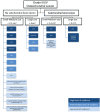Algorithm for Treatment of Focal Cartilage Defects of the Knee: Classic and New Procedures
- PMID: 33745340
- PMCID: PMC8808924
- DOI: 10.1177/1947603521993219
Algorithm for Treatment of Focal Cartilage Defects of the Knee: Classic and New Procedures
Abstract
Objective: To create a treatment algorithm for focal grade 3 or 4 cartilage defects of the knee using both classic and novel cartilage restoration techniques.
Design: A comprehensive review of the literature was performed highlighting classic as well as novel cartilage restoration techniques supported by clinical and/or basic science research and currently being employed by orthopedic surgeons.
Results: There is a high level of evidence to support the treatment of small to medium size lesions (<2-4 cm2) without subchondral bone involvement with traditional techniques such as marrow stimulation, osteochondral autograft transplant (OAT), or osteochondral allograft transplant (OCA). Newer techniques such as autologous matrix-induced chondrogenesis and bone marrow aspirate concentrate implantation have also been shown to be effective in select studies. If subchondral bone loss is present OAT or OCA should be performed. For large lesions (>4 cm2), OCA or matrix autologous chondrocyte implantation (MACI) may be performed. OCA is preferred over MACI in the setting of subchondral bone involvement while cell-based modalities such as MACI or particulated juvenile allograft cartilage are preferred in the patellofemoral joint.
Conclusions: Numerous techniques exist for the orthopedic surgeon treating focal cartilage defects of the knee. Treatment strategies should be based on lesion size, lesion location, subchondral bone involvement, and the level of evidence supporting each technique in the literature.
Keywords: articular cartilage; cartilage repair; cartilage transplantation.
Conflict of interest statement
Figures






References
-
- Gomoll AH, Lattermann C, Farr J. General treatment algorithm for cartilage defects. Cartil Restor. 2013:39-49. doi:10.1007/978-1-4614-0427-9_4 - DOI
Publication types
MeSH terms
LinkOut - more resources
Full Text Sources
Other Literature Sources
Medical

